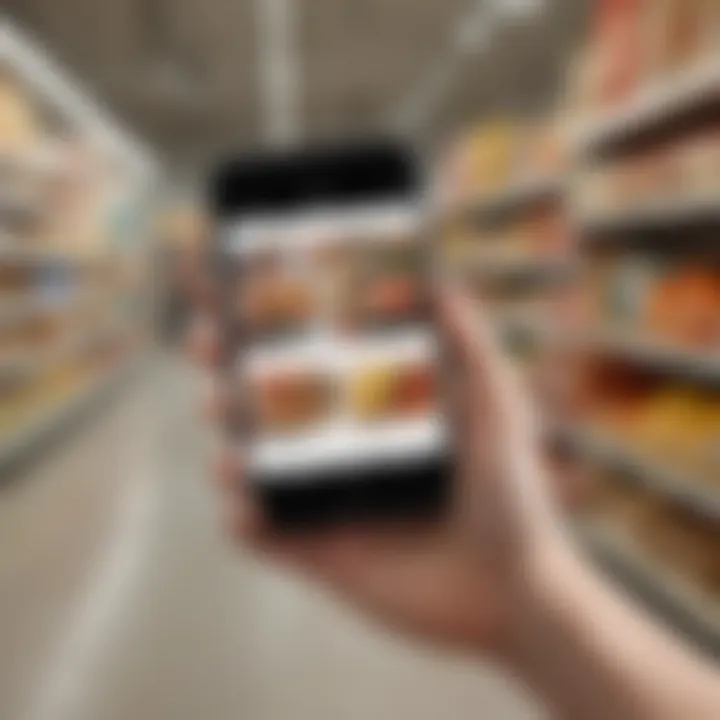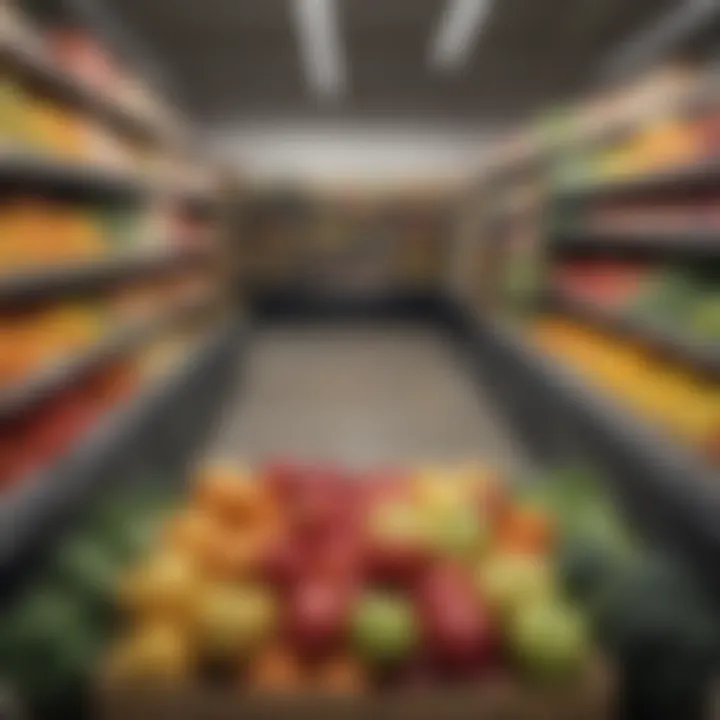Exploring Curbside Pickup Options in Grocery Stores


Intro
The rise of curbside pickup in grocery stores marks a significant shift in consumer behavior and retail operations. As people increasingly prioritize convenience, many grocery retailers have adopted this model. This article explores what curbside pickup entails, gives insight into the benefits and possible limitations, as well as the variety of available options offered by major chains and local stores. These services have reshaped not just the shopping experience, but have also reflected a broader change in how modern consumers approach grocery shopping.
Understanding the rationale behind curbside pickup empowers consumers. They can make informed choices that align with their lifestyles. Grocery shopping has traditionally involved strolling through aisles, but curbside provides flexibility when scarce time exists. Shoppers can now order items online and simply retrieve their groceries from a designated pickup location.
This flexible method particularly flourished during circumstances that necessitated physical distancing, although its relevance continues. Both large supermarkets, like Walmart and Kroger, and local stores are quickly adapting to this trend, emphasizing their commitment to customer service. As these options expand, it's beneficial to delve into how each element works.
Next, we will discuss the Operational Processes that underlie curbside pickup services, highlighting its merits and flaws. This will give a comprehensive view of how these methods can fit different shopping habits.
Preamble to Curbside Pickup
Curbside pickup emerges as a response to shifting consumer needs and preferences in grocery shopping. It allows shoppers to order items online and collect them without entering the store. This practice underscores the growing desire for convenience, safety, and time management in today's fast-paced world. The introduction of curbside pickup has become a lifeline for many consumers who appreciate minimizing the time they spend in stores.
Understanding Curbside Pickup
Curbside pickup is characterized by its straightforward process. Consumers can browse through a store’s digital inventory on a website or app, select their desired items, and pay online. Once they arrive at the designated pickup location, they notify the store, and staff members bring their order directly to their vehicle.
This method of grocery shopping eliminates crowds and instances of impulse buying, making it attractive for many. Moreover, with the right planning, curbside pickup can lead to a curated shopping list, aiding customers in avoiding unnecessary purchases. The clarity of this system highlights its effectiveness in catering to current shopping preferences while enhancing overall customer satisfaction.
The Rise of Convenience in Grocery Shopping
The trend toward convertinc grocery shopping has swelled significantly. More customers are choosing online ordering because of the numerous benefits it offers. This method has become crucial, especially after the impact of global events like the COVID-19 pandemic, forcing adaptations in local shopping behaviors.
Convenience is no longer a luxury; it is now a necessity. Availability of quick fulfillment options like curbside is often viewed as part of excellent customer service. As grocery chains embrace modern consumer expectations, the need for efficiency and convenience will continue to shape the industry.
Curbside pickup is more than just convenience; it’s a transformation in the way we approach grocery shopping, adapting to the demands of a changing world.
In summary, understanding curbside pickup is vital for shoppers who prioritize convenience while managing their time effectively. This shift in the supermarket landscape has implications for both consumers and businesses, making it essential knowledge for anyone involved in grocery retail.
Major Grocery Chains Offering Curbside Pickup
Curbside pickup has become a vital feature in grocery shopping, especially during recent years. The growing demand for convenience and efficiency has led major grocery chains to adapt their services accordingly. This section outlines some major grocery stores that offer such services, highlighting their unique advantages and characteristics.
Walmart
Overview of Services
Walmart provides a robust curbside pickup service. Customers can browse and select items using the Walmart app or website. The process is fairly easy, allowing users to add items like groceries or household supplies to a virtual cart. Walmart’s large inventory includes groceries, furniture, electronics, and more. This versatility is a key characteristic of their service.
With users getting the chance to avoid long lines in-store, Walmart's curbside pickup is often popular due to the simplicity it offers. One unique feature is the ability to choose a time slot for pickup. This allows for better planning and ensures fresh items on arrival.
Availability and Fees
Walmart's curbside pickup is widely available across many locations. Most areas have service systems in place allowing for smooth operation. Fees associated with this service are generally low. In some locations, it is entirely free, provided the minimum purchase criteria is met. However, certain products might incur additional fees. Overall, Walmart's model aims to maximize accessibility without overwhelming customers with excessive costs.
Target
Target's Curbside Approach
Target's curbside pickup also also draws significant attention. Target aimed for a blend of inclusivity in product selection and ease of use. The targeted design of their app allows customers to maximize efficiency while shopping. This personalized shopping approach has become a key asset.
Another advantage is Target’s emphasis on quality. Products are collected and organized with detailed care, ensuring proper handling even before the owner arrives at the pickup location. This meticulous attention fosters repeat customer behavior.
Order Fulfillment Process
The order fulfillment for Target’s curbside service is streamlined. Once customers place their order, staff quickly gather and prepare the items. Notifications alert users when their orders are ready. This system puts pressure on operational efficiency but often leads to a restrained timetable for fulfillment. Target generally excels in providing upscale items alongside common groceries, making it popular for diverse shoppers.
Kroger
Benefits for Customers


Kroger’s curbside pickup system has redefined the benefit structure for customers. One primary feature is the personalization that accompanies their service. Customers can organize their favorite shopping lists, which saves time and helps streamline their orders.
Additionally, Kroger focuses on enhancing their application for customer use efficiency. The notewrthy benefits resonate with users about consistent quality in grocery items. Shoppers can feel assured that their items will be selected fresh and of premier quality.
Integration with Digital Platforms
Kroger makes extensive use of digital tools to ensure seamless interaction. Its integration with online shopping environments enables users a streamlined transition from offline to online shopping experience. Their app Facilities targeted promotions and coupons to incentivize routine shopping behavior.
Users find that they can save substantial amounts over time. While benefits are high, continued reliance on technology can be seen as a double-edged sword, as many users are dependent on stable internet to access such conveniences.
Instacart Partner Stores
Overview of Instacart
Instacart serves as a connecting bridge between customers and their favorite grocery stores. This innovative model allows shoppers to browse products from various stores in one place. Instacart represents a notable ease-of-use characteristic that makes continuous engagement possible.
As for accessibility, Instacart opens up numerous local stores not typically associated with large chains. Instant delivery options further bolster its attractiveness. However, some users note inflated product pricing, which sometimes curtails the utilization of the service compared to direct store options.
Access to Local Grocery Stores
One major highlight is how easily Instacart connects customers with local grocery stores. This benefit allows individuals to keep purchasing habits grounded locally. Customers often appreciate the variety available, moving beyond just the products typical major grocers offer.
Partnering with local stores allows Instacart to deliver more tailor-fitted choices to specific communities.
In essence, the mechanism of curbside pickup through major grocery chains presents varied key points of value. From operational aspects to digital integration, each brand adapts to make grocery shopping convenient.
Regional Grocery Stores with Curbside Pickup
Regional grocery stores play a vital role in providing curbside pickup options. They often serve specific communities and address the unique needs of local shoppers. These stores can offer personalized service and cater to regional preferences, which enhances the overall experience.
With a focused distribution, regional grocery chains often introduce innovative solutions that larger chains might overlook. Localized inventory management helps in ensuring that essential products are readily available for pickup. Shoppers appreciate these qualities as they often seek conveniently sourced and regionally preferred items. In this article, we will explore several regional grocery stores, detailing their curbside services and evaluating the benefit they present to consumers.
ALDI
Service Expansions
ALDI’s approach to service expansions has been quite strategic, enabling it to adapt to increased consumer demand for convenience. In many regions, ALDI has recently invested in enhancing their curbside pickup services, which stand out due to lower pricing compared to competitors. Many consumers find their operations simple, which makes the shopping experience efficient.
One unique feature of ALDI's service is the limited yet focused offerings, promoting a quicker shopping process. However, the trade-off may lie in inventory depth. Their streamlined inventory can mean fewer choices, but shoppers gain speed and affordability, ideal for today’s fast-paced environment.
Customer Feedback
Customer feedback is critical for ALDI’s curbside pickup services, as it provides insights into user experiences and areas ripe for improvement. Customers often note the effectiveness and accessibility of the ordering platforms, and ALDI’s efficient staff plays a key role in this.
The main feedback from these customers highlights the satisfaction derived from down-to-earth pricing and effectiveness in the process. The unique aspect lies in the community feel created through their service. On the downside, changes based on feedback may sometimes lag behind customer expectations, and ensuring consistency across locations can pose some challenges.
Safeway
Grocery Selection
Safeway’s grocery selection underpins their popularity in the daycare clustering market, where various customers need diverse options. By offering an extensive range of local and organic products, Safeway attracts a broad customer base. Their ability to curate selections tailored to neighborhood preferences strengthens community ties and secures repeat clientele.
Safeway's unique feature lies in their user-friendly app. Customers can easily access promotions and their favorite items, enhancing their shopping experiences. The downside, however, is potential stock variability, which can frustrate consumers expecting certain choices.
User Experience
The user experience at Safeway is another significant factor contributing to the success of their curbside pickup service. Customers frequently comment on how seamless the digital platform integrates with in-store operations. Easy navigation through the app allows users to place their orders without unnecessary searching.
An important characteristic is the emphasis on real-time inventory. This lowers the chances of people picking up items that aren't truly available. However, sometimes there can be digital problems, like app glitches slowing down the process.
Trader Joe's
Adapting to Demand


Trader Joe's has impressed many with its responsiveness to growing demand for curbside services, amending its strategies to address consumer preferences. With more focus on online engagement, Trader Joe's has curated an online shopping experience complementing their unique stocked items that gives them a competitive edge.
The ability to adapt to changing demand characteristics reflects the strength of customer loyalty they enjoy. While the unique offerings create distinction, they may struggle with delivering all entrées due to stock issues. If limitations wish to provide variety but without having sufficient inventory ready for pickup, this could dissuade future orders.
Community Impact
Trader Joe's commitment to the community goes beyond sales; the pandemic highlighted many grocery’s roles in supporting local initiatives. The community-centric ethics have solidified its identification with locals throughout the years; this fills a gap for many who prioritize supporting advocacy for smaller charities.
With community impact generation central to their operations, they have endeavored to strengthen lax relationships while remaining influential in the local economy. While that dedication flourishes gratitude, lingering concerns in logistical efficiencies might lead to wider problems, primarily when attempting to harmonize this altruism with demand logistics.
The Process of Utilizing Curbside Pickup
The utility of curbside pickup is intricately woven into the fabric of modern grocery shopping. This section lays essential groundwork, guiding the reader through a seamless experience of curbside grocery collection. A thorough understanding of this process can enhance convenience and diminish any potential frustration associated with grocery shopping.
Placing an Order
Using Mobile Apps
Mobile apps mark a significant advancement in placeing grocery orders. Their primary contribution to grocery shopping is ease of access. Shoppers can browse through items quickly, select their preferences, and place orders on-the-go. One key characteristic of using mobile apps is their intuitiveness; most users can navigate these applications without extensive guidance. The unique feature of mobile apps is their ability to send notifications regarding order status, which enhances the overall experience.
However, some drawbacks exist, including the need for a stable internet connection and the limitations of smaller screens during navigation. Despite these concerns, mobile apps remain a powerful tool for efficient grocery shopping.
Desktop Experience
In contrast, the desktop experience offers a different scope of convenience. With larger screens, shoppers can view comprehensive layouts and make informed choices without straining their eyes. The key characteristic of desktop shopping is its detailed organization of numerous categories, which aids users in finding items quickly. Especially during the planning of weekly meals, the ability to compare multiple products on a single screen is beneficial.
A unique feature of this experience is the availability of online loyalty programs, which can enhance savings for frequent shoppers. Although desktops can feel less accessible than mobile apps, they offer precision and a larger view.
Checking-In for Pickup
Notification Systems
Next in the curbside process is checking in for pickup. Notification systems play an invaluable role as they keep customers informed. They notify customers of their order readiness, as well as any delays. This system's key characteristic is real-time communication, which supports time management. The convenience of knowing when orders are ready cannot be overstated.
The uniquefeature allows users to confirm their arrival easily, avoiding long wait times. This system can sometimes fail, causing confusion. Overall, efficient notification systems are indispensable for a hassle-free pickup experience.
Timing Considerations
Timing considerations refer to how consumers synchronize their pickups with store operations. Recognizing busy periods can save customers considerable waiting time. A critical aspect of timing is planning ahead—shoppers must pick ideal windows based on their schedule. The significant characteristic of well-timed pickups is reduced stress, providing much-needed convenience.
Innovation in scheduling functionalities, like selecting the best pickup slots through various apps, enhances user choices. Timing can become a disadvantage when unexpected delays arise, potentially disrupting customer plans. Nonetheless, mindful timing of pickups constitutes an effective strategy respective to curbside services.
Collecting Groceries
Safety Protocols
As consumers prepare to collect their groceries, safety protocols gain paramount importance. They serve to protect shoppers and staff during the pickup process. A key characteristic of safety protocols is their focus on minimizing contact points. Governments and store policies often dictate these protocols. The implementation of designated pickup zones and proper sanitation presents a unique feature—ensuring safety without undue delay.
Some customers may find these measures inconvenient; however, they remain crucial in a meticulous shopping environment where buyers seek familiar but streamlined methods.
Quality Assurance
Finally, quality assurance things come into play when collecting orders. The goal is to guarantee shoppers receive products that meet their standards. One characteristic of quality assurance is thorough checks before loading items into customer vehicles. Major retailers emphasize this procedure to preserve customer trust and satisfaction.
On the contrary, the unique feature such as color coding by product types ensures there are no obligation errors. Customers could sometimes receive items that do not meet their preferences. Sustaining quality assurance forms the basis of curbside pickup, consistently aligning services with shoppers’ expectations. Thus, quality assurance is both a promise and obligation successful curbside services must uphold.
Benefits of Curbside Pickup
Curbside pickup offers several important advantages for consumers. Understanding these benefits is key in deciding whether to incorporate this service into one's grocery shopping routine. Let's delve into the various aspects that make curbside pickup a choice worth considering.
Time Efficiency


In today's fast-paced world, time is critical. Curbside pickup significantly enhances time efficiency. By allowing customers to order groceries online, time spent in rows aisles reduces greatly. Many grocery chains have optimized their online platforms. Therefore, customers can easily select their items and complete the transaction from the comfort of their home.
Coordination between preparation and pickup exists. Some stores even offer scheduling options where a customer can select a specific pickup time. This helps in reducing wait periods upon arrival. Transactions can feel seamless. Less idling by searching or checking stock helps make grocery outings faster. Curbside pickup often means fewer decisions to make in a store, ultimately saving precious time.
Reduced Exposure to Crowds
A major draw for grocery shoppers is the reduced exposure to crowds. In contexts where health concerns loom, the need to minimize interactions with larger groups rises considerably. Curbside pickup addresses this necessity effectively. Customers can avoid rows of people and lines during busy hours.
Accomplishing grocery sopping via curbside means collection is outside, lessening the complexities of indoor shopping. Many customers prefer solitary pickup to navigate their grocery needs without the anxiousness commonly felt in crowded stores. Curbside pickup thus enables a practical solution for health-conscious consumers.
Ability to Compare Prices
Lastly, curbside pickup affords an ability to compare prices with ease. This practice takes online grocery shopping a step beyond traditional methods. Having the prices in a digital format allows customers to see total costs streamlined without the pressure of shopping in-store.
External resources, various apps, or specialized websites provide comparative pricing, which allows consumers to find best deals before finalizing their transactions. Whether choosing fresh produce or pantry staples, taking the time to ensure the right price enhances satisfaction and prudent spending habits. If you make use of curbside options, you can initiate orders quickly—and change your selections as new promotions arise—ultimately making smarter shopping decisions.
Curbside pickup transforms grocery shopping, catering to the necessities of efficiency, safety, and informed decision-making for today’s busy consumers.
Limitations and Challenges
Curbside pickup services may ars offering convenience to many shoppers. Forums and studies highlight specific limitations and challenges they confront. Many consumers are eager to understand these obstacles. This assurance aids in informed decision-making when relying on curbside pickup options for groceries.
Product Availability
One notable limitation concerns product availability when using curbside pickup. Not every item in-store is ready for online ordering. Shoppers may find that certain popular products are out of stock. This could leave them frustrated when relying on curbside pickup. For instance, seasonal items or promotions might not be available through online platforms. Immediate substitutes might not be offered for special requests, leading to adjustments being necessary. This is a definite consideration that every shopper should ponder when placing online orders. Moreover, availability can vary between regional stores and major chains, making it essential to know one's local grocery's stock practices.
Potential Fees and Costs
A second challenge lies in the potential fees associated with curbside pickup. While many stores advertise their services as free, hidden costs can still appear. Some chains variety additional fees, such as service charges, which can alter the cost perception. This can dishearten shoppers who thought they would benefit from a completely free service. Other unexpected charges may arise from necessary substitutions or changes made during pickup. It is important to carefully review each grocery's pricing policy.
Dependent on Technology
Finally, reliance on technology stands as a key limitation. Customers expect a seamless experience with user-friendly online platforms. However, technical issues can arise, from website downtimes to problems with the mobile app. Shoppers depend on their ability to sign in, browse products, and place orders correctly and in time. If the system falters, it leads to dissatisfaction which can deter customers from using the service. Additionally, some consumers may not be confident using these technologies, especially older generations who may feel overwhelmed. It’s crucial that grocery stores promptly address these technology challenges for the curbside pickup method to be fully beneficial.
Understanding and recognizing these limitations helps consumers weigh the pros and cons of curbside pickup services. By being well-informed, customers can better navigate options and align their shopping experiences with their personal needs.
The Future of Curbside Pickup
Curbside pickup has transformed the way consumers purchase groceries. This shift is due to a growing awareness of convenience and efficiency in shopping behavior. In the future, curbside pickup will likely evolve further as technology continues to advance. Stores will have more tools to fulfill customer needs. Businesses that ignore these trends may fall behind in serveing customers efficiently.
Technological Advancements
Machine Learning Integration
Machine learning is key to enhancing the curbside pickup experience. The capacity to analyze consumer behaviors allows grocery stores to streamline order fulfillment. Algorithms learn from past shopping trends, aiding in inventory management and personalizing recommendations based on shopper preferences. A prominent characteristic is its ability to enhance accuracy in order picking, which in turn reduces error rates and improves customer satisfaction.
The unique advantage of this technology is its self-adapting nature. With time, systems improve efficiency and customer experience without needing substantial manual input. However, there may be challenges, such as data privacy concerns. Customers expect a seamless experience, yet data security remains critical. Overall, adopting this technology is crucial for stores aiming to stay competitive.
Mobile Optimization Trends
Mobile optimization trends focus on enhancing user and shopping experiences via mobile devices. Smartphone applications are becoming increasingly central for placing and managing curbside orders. They allow for easily modified orders and statuses. A critical characteristic of mobile optimization is responsiveness. The ability for apps to adapt to different screen sizes ensures that customers can navigate smoothly.
One unique feature is in-app notifications. These alerts keep customers informed about their orders and when to arrive for pickup. Yet, optimization requires ongoing updates and maintenance, costing businesses time and resources. Maintaining user-friendly interfaces that fulfill user expectations is necessary for continued usage. This improves overall consumer satisfaction and loyalty, making it essential for future growth.
Shifting Consumer Preferences
Impact of COVID-19
The COVID-19 pandemic presented and accelerated the need for efficient, contactless shopping options. As restrictions grew, many consumers turned to curbside pickup, drawn to its ability to reduce exposure to crowded spaces. This particular shift illustrates a fundamental change in grocery shopping. Health concerns drove a massive adoption of curbside services, revealing long-term preferences for convenience and safety.
A unique insight from this transformation is the emphasis on hygiene and contactless transactions. Businesses are now competing in delivering not only products but also a sense of security. The fear associated with health risks has resulted in a permanent preference for easy access to stores. This forms a solid argument for curbsides listing valuable online benefits instead as stores want to operate amidst the pandemic.
Evolving Shopping Habits
Evolving shopping habits indicate that convenience defines modern consumer behavior. Daily routines are reflecting the need for speed and efficiency in grocery purchases. Shoppers prioritize minimizing time spent in stores, which makes curbside pickup a favored option.
A distinctive aspect is the balance between quality and convenience. Shoppers expect quality products from their orders but also increasingly value time over various competing factors. Maintaining high standards while catering to evolving demands will be a challenge for providers and adaptability is essential. The capacity to capture and retain consumer interest stems from understanding these changing habits, making investments in curbside options even more critical for retailers wanting to sustain growth in future shopping environments.
In summary, the future of curbside pickup will rely on technological advancements and shifting consumer habits. Integrating machine learning and optimizing mobile experiences will enhance convenience and responsiveness. Health and changing routines emphasize that businesses need to be nimble to adapt and evolve. Whichever retailer successfully capitalizes on these insights will have an influential presence in the landscape of grocery shopping.







